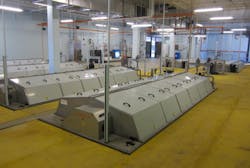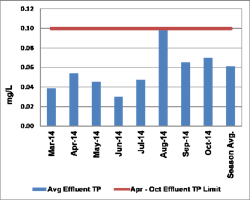The North Attleborough (Mass.) Wastewater Treatment Facility (WWTF) received a renewed discharge permit that required it to meet a monthly average effluent total phosphorus (TP) limit of 0.1 mg/L. The WWTF planned for biological nutrient removal (BNR) process upgrades, but also needed a tertiary treatment process to guarantee that the stringent limit would be met. The facility wanted to use the existing footprint and infrastructure for the new upgrades in order to minimize project cost and avoid the need to expand the facility footprint.
The Solution
The North Attleborough Department of Public Works collaborated with its local consulting engineer to evaluate viable tertiary treatment alternatives to meet the facility’s needs. The facility considered a number of options, and onsite pilot tests were conducted for several treatment technologies. Upon completion, the Hydrotech Discfilter system with upstream chemical pretreatment was selected for tertiary TP removal. The system offered the benefit of low life cycle cost, the ability to fit within the footprint of the existing traveling bridge filter building and the facility’s hydraulic profile, and the characteristic of being easy to operate and maintain. The system has since proven to meet the design parameters through initial performance testing as well as continued long-term operations.
Process Description
The Hydrotech Discfilter system for the North Attleborough WWTF was designed to treat a peak hour flow of 17 million gal per day (mgd) and an average day flow of 4.8 mgd while achieving an average effluent TP of ≤0.1 mg/L. Upstream of the filters are two mixing zone trains to precipitate and flocculate the phosphorus from soluble to particulate form that can be captured and removed by the filters. Each train has one rapid mix zone (with one vertical shaft rapid mixer), followed by three coagulation/flocculation zones (each with one vertical shaft slow speed mixer). Coagulant is dosed upstream of the rapid mix zone, while polymer is dosed downstream of the first coagulation zone. The system includes six model HSF2224-2F Hydrotech Discfilter units and is monitored and controlled by an integrated instrumentation and control system.
[Visit Kruger's W&WD Storefront]
The facility operates the Discfilters year-round for effluent total suspended solids (TSS) polishing, but only operates the chemical pretreatment system as required to meet the WWTF’s TP limits. In March 2014, the facility began dosing chemicals and operating the pretreatment system in conjunction with the Discfilters in preparation for the lower limit that would be required by permit starting in April 2014. The effluent TP averaged below the permit limit of 0.1 mg/L. The system continues to operate and enable the WWTF to meet permit limits.
Results
The Hydrotech Discfilter installation was the first cloth media filter installation specifically designed to achieve effluent TP of ≤0.1 mg/L. The system was able to conveniently fit within the existing facility footprint and hydraulic profile, while providing the benefit of simple operation and maintenance. The process includes chemical pretreatment to precipitate soluble phosphorus. The Discfilter removes the precipitated phosphorus as well as phosphorus bound in the TSS from the upstream BNR process. Since commissioning in 2013, the Hydrotech Discfilter has provided the site with continued high performance and enabled the WWTF to successfully achieve the stringent effluent requirement of ≤0.1 mg/L TP.

